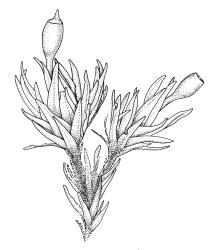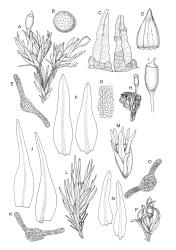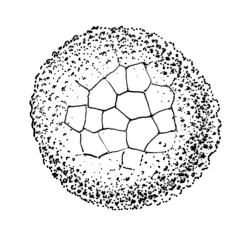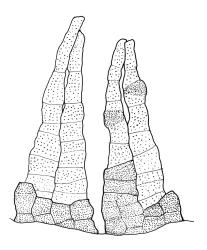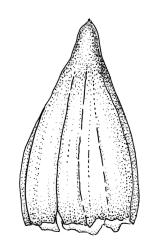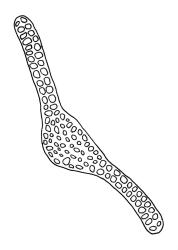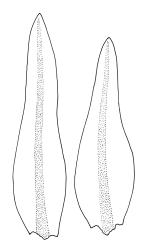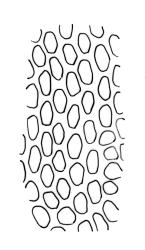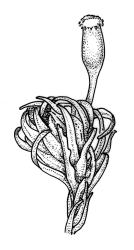- ≡ Muelleriella crassifolia (Hook.f. & Wilson) Dusén, Bot. Not. 1905: 304 (1905) subsp. crassifolia
Plants mostly black-green, brown, or dark black, sometimes yellow-green above, forming tufts, cushions, or small mats. Stems erect, unbranched or once-branched, sparsely beset with smooth brown rhizoids, <10 mm. Leaves tightly or loosely erect and incurved when dry, erect-spreading or spreading when moist, ligulate-lanceolate or ligulate from an obovate or ovate base, a few ± ovate-lanceolate, obtuse or broadly or occasionally sharply acute, bistratose above, entire, plane, 1.4–3.2 × 0.5–1.0 mm (including perichaetial); margins 2–3-stratose; mid and upper laminal cells irregularly rounded to hexagonal-rounded, a few usually oblate, smooth, (6–)8–13 µm wide; interior basal cells short-rectangular to quadrate, c. 1–3: 1, mostly 18–30 × c. 9 µm, rarely with a border of clear cells. Costa as per genus, stout, elliptic in cross-section at mid leaf. Gemmae absent.
Gonioautoicous. Perichaetial leaves larger but otherwise similar to vegetative. Perigonia gemmiform on lower stems. Setae stout, straight or sometimes slightly curved, (0.8–)1.0–2.6(–2.8) mm, capsules oblong- to ovate-cylindric when moist, usually constricted below mouth when dry, occasionally asymmetric, erect, emergent to exserted (often appearing more clearly exserted when dry), yellow-brown, fairly sharply contracted to the seta, 1.0–1.8 × 0.5–0.9 mm; exothecial cells c. 20–40 µm at mid urn with strongly incrassate longitudinal walls; stomata immersed, numerous, and restricted to lower half of capsule; annulus absent; operculum obliquely rostrate, yellow-brown at maturity. Peristome single; exostome teeth 16, spreading when mature and dry, recurved when old and dry, triangular-lanceolate, inserted below the mouth, often irregular and ± perforate near apex, coarsely and irregularly papillose; preperistome irregular in outline and extending c. 1–4 cells beyond the capsule mouth, often also forming irregular papillose plates on upper portions of teeth; endostome absent. Calyptra conic-mitrate, naked. Spores multicellular, yellow-green, spherical to ovoid or irregularly cubic, (30–)40–100 µm.
Vitt 1976, figs 24–27, 34 (as Muelleriella crassifolia subsp. crassifolia); Seppelt 2004, fig. 82 (as Muelleriella crassifolia subsp. crassifolia); Ochyra et al. 2008, fig. 184 (as Muelleriella crassifolia).
Orthotrichum crassifolium subsp. crassifolium is a somewhat variable taxon, differentiated from O. angustifolium and O. aucklandicum by its leaves, which are blunter, more ovate, erect-incurved, and rather stiff, and by its emergent to exserted, cylindric capsules.
The present species could be confused with Zygodon menziesii when sterile, but O. crassifolium subsp. crassifolium has more obtuse and bistratose leaves. The bistratose laminal cells of the present species make the leaves appear more opaque, even at low magnification. The smooth capsule and multicellular spores are strikingly different.
SI: Otago (Taieri River Mouth, Akatore River, Bull Creek, Curio Bay, Cannibal Bay); St; Ch (Ocean Bay); Sn; A; Ant; C; M.
Austral. Antarctic Peninsula*, S Shetland Is.*, Argentina*; recorded from the Brunswick Peninsula of Chile, Falkland Is., and Marion I. by Vitt (1976), who considered the subsp. acuta to be "almost certainly endemic to Kerguelen and Crozet Islands".
Restricted or nearly restricted to supratidal and salt spray zones, where it grows on the tops and sides of boulders or on rock outcrops; occasionally also occurring in the upper intertidal zone. On Auckland Is most collections (largely by D.H. Vitt) were made in Metrosideros/Olearia forest and range from "near sea level" to c. 50 m elevation. Vitt (1976, p. 102) also records several specimens from inland sites on Auckland I. (mostly from St. Col Ridge). Seppelt (2004) recorded it from sites up to 130 m elevation but stated that "it is sometimes encountered on rocks on elevated coastal slopes and a few collections have been made from isolated plateau localities, but its primary habitat is the supralittoral zone." The known distribution of this species on the Otago coast is limited and it may be under-collected there; only two collections have been seen from Stewart I.
The restriction of a moss species to littoral sites is exceedingly rare. No other N.Z. moss, including its congeners, exhibits such a marked tolerance of salt as O. crassifolium subsp. crassifolium. The unrelated Calyptrochaeta apiculata, however, is largely restricted to habitats subject to salt spray, and occurs on a range of substrates including rock and sand. Macromitrium longirostre s.l. and M. brevicaule occur on both bark and rocks subject to salt spray in part or all of their N.Z. range. The rare (in N.Z.) pottiaceous mosses Tortella cirrhata and T. flavovirens appear to be restricted to maritime sites here, as does the unrelated Ischyrodon lepturus. Ulota phyllantha, a species growing most often on rock in the southern hemisphere and strongly restricted to maritime localities, is widely distributed in the northern hemisphere. It occurs (probably adventively) on Macquarie I. and in Patagonia.
Goffinet (in Goffinet et al. 2004) published the combination Orthotrichum crassifolium Hook.f. & Wilson subsp. acutum (Müll.Hal.) Goffinet, mirroring the taxonomic conclusions presented by Vitt (1976) in his monograph of Muelleriella. In publishing the subsp. acutum in Orthotrichum, Goffinet created the autonym Orthotrichum crassifolium Hook.f. & Wilson subsp. crassifolium, the name by which this taxon should be known in N.Z.



